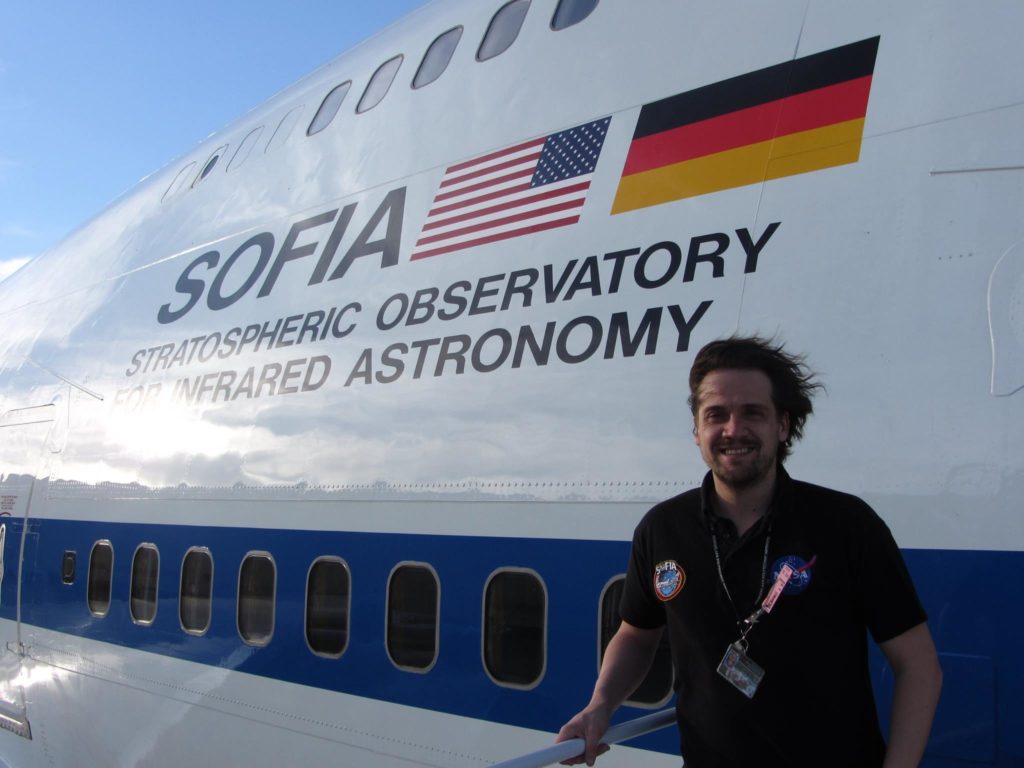The airborne Stratospheric Observatory for Infrared Astronomy (SOFIA) is a flying observatory aboard a modified Boeing 747 that takes infrared astronomy readings at approximately 41,000 feet above the Earth’s surface.
It recently observed a mini-eclipse of the extrasolar planet named “GJ 1214b”. Scientists wanted to find out if this world outside of our solar system is a super-sized Earth or a miniature Neptune. It was the first time SOFIA did observations of this kind and it was demonstrated that SOFIA can indeed help answer questions like this in the future.
Daniel Angerhausen, a research scientist with the Blue Marble Space Institute of Science, tells us about his experiences working on board SOFIA.
When I first saw SOFIA I was an undergraduate student at Cologne University in Germany: a poster at the Astrophysics Institute was advertising science with the ‘Stratospheric Observatory for Infrared Astronomy’ — a crazy sounding idea of NASA and the German Space Agency DLR to put a 2.5 meter telescope on board of a Boeing 747-SP Jumbo Jet. Astronomical observations from the ground, even on the highest mountains, suffer a lot from disturbing effects of the Earth’s atmosphere. Flying slightly higher than commercial airplanes with SOFIA makes that much less of a problem – SOFIA, in that sense, is a space telescope that comes home every morning. At that time, Cologne University was involved in building astronomical instruments that were supposed to fly on SOFIA, which was still in development. At the time, I thought of how cool it would be to maybe one day be involved with such a fascinating mission.
After one college degree, a PhD, and two postdoctoral positions, I am finally sitting here writing about my experiences actually flying with SOFIA.
 I tweeted, “Last night I flew on a billion dollar NASA plane to observe an alien world 42 light years away. How was your night?” when I got off the plane the next morning after our observation. It wasn’t the first time I flew on SOFIA, as I had done two or three test flights before, but it was the first time that we could use all the instruments available on SOFIA for the science that I am interested in: transits of extrasolar planets.
I tweeted, “Last night I flew on a billion dollar NASA plane to observe an alien world 42 light years away. How was your night?” when I got off the plane the next morning after our observation. It wasn’t the first time I flew on SOFIA, as I had done two or three test flights before, but it was the first time that we could use all the instruments available on SOFIA for the science that I am interested in: transits of extrasolar planets.
“Transits” of extrasolar planets are relatively rare events occur when a planet outside our solar system lines up between Earth and that planet’s host star. During a transit, the planet occults, or covers, parts of the star and dims its light like in an eclipse. Also, some of the light of the star passes through the atmosphere of the planet all the way to us. When we detect that light, it can tell us about the composition, temperature, pressure and other characteristics of that planet’s atmosphere. However, when we observe these transits from the ground, even from the best sites in Chile or Hawaii, the measurements are compromised because they also have to pass through the Earth’s atmosphere. That is why getting high on SOFIA is so important for this science case.
Our target that night was the exoplanet GJ 1214 b, a so-called ‘mini-neptune’ or ‘super-earth’. Intermediate-sized exoplanets like GJ 1214b are relatively common, but we don’t have a planet that size in our own solar system to use for comparison. Our observation was designed to give some more data for the theorists to determine if GJ 1214b is more of a large rocky world or a gaseous, icy, shrunken Neptune.
As it is with all new missions, there were occasional problems that we learned to avoid or fix for future observations. However, we were still able to push the instruments to 1.5-2 times their theoretical limit. While our results have not yet answered our big questions about the nature of the exoplanet GJ 1214b, they showed that SOFIA has the sensitivity to play with the other kids in the exoplanet transit league like the Hubble or Spitzer space telescopes in the future. While SOFIA will most likely not become a work-horse starting player like these two, it can very well come off the bench for some tricky kicks or special plays that only SOFIA will be able to do. For me, and everyone else involved with SOFIA, this means a lot more exciting exoplanet hunting is in our future.
[embedyt] https://www.youtube.com/watch?v=y-W3xoOu0NE[/embedyt]
Other coverage of this mission can be found here:
Press Release in German: http://www.unibe.ch/aktuell/medien/media_relations/medienmitteilungen/2017/medienmitteilungen_2017/mit_einem_fliegenden_teleskop_ferne_welten_aufspueren/index_ger.html
Press Release in English
http://www.unibe.ch/news/media_news/media_relations_e/media_releases/2017_e/media_releases_2017/searching_for_distant_worlds_with_a_flying_telescope/index_eng.html


